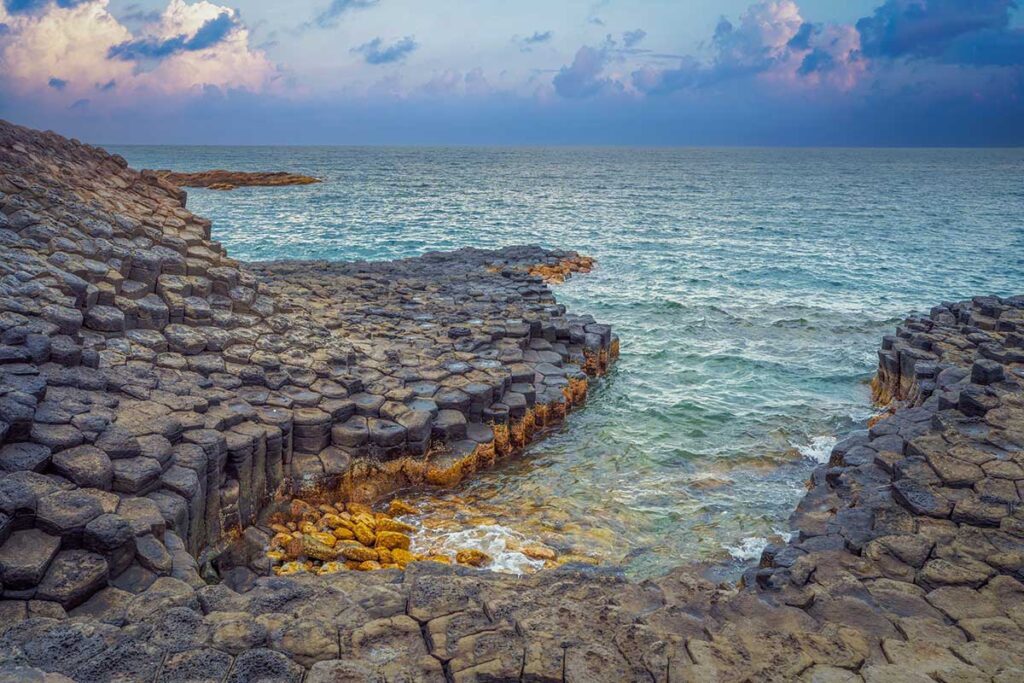What is Da Dia Reef (Ganh Da Dia)
Location & Geology in One Look
Da Dia Reef sits in Tuy An District, about 30–38 kilometers north of Tuy Hoa, the capital city of Phu Yen Province. The formation was created millions of years ago when basalt lava flows from volcanic eruptions met the sea, cooling rapidly and cracking into natural geometric patterns. The result is thousands of hexagonal, pentagonal, and other polygonal stone columns stacked tightly together, giving the impression of carefully arranged plates.
Scale, Shape & Recognition
The reef stretches along a coastal strip roughly 100 to 250 meters long and is made up of what is often estimated at around 35,000 basalt columns.

From above, it looks like a giant beehive, while up close the stones resemble piles of black dinner plates. In recognition of its geological and cultural significance, Da Dia Reef has been classified as a national scenic site and later upgraded to a Special National Relic in Vietnam.

Name & Local Lore
The Vietnamese name “Ganh Da Dia” or “Ghenh Da Dia” translates as “Sea Cliff of Stone Plates,” a reference to the stacked, dish-like appearance of the rocks. Local folklore adds another layer: one tale claims the rocks were once stone plates carried and dropped by a giant, leaving behind this unusual natural mosaic.
Visiting Da Dia Reef: What to Expect
1. On-Site Layout & Viewpoints
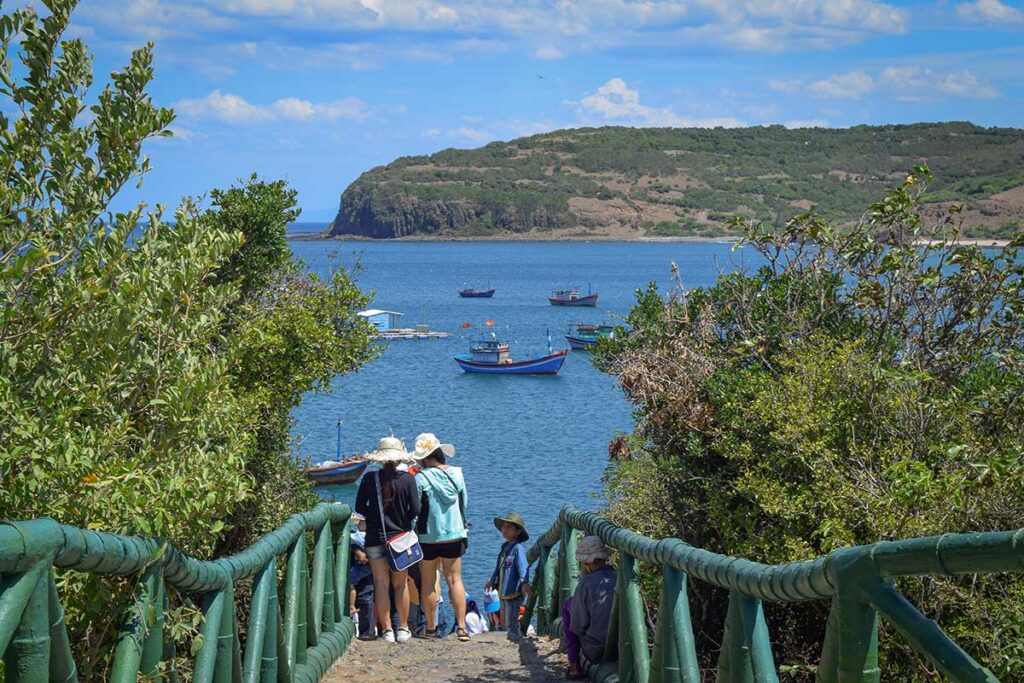
From the entrance, it’s only a short walk along a paved path before you reach the basalt formations. The main cluster is where most people gather for photos — a jagged black platform meeting the turquoise sea.
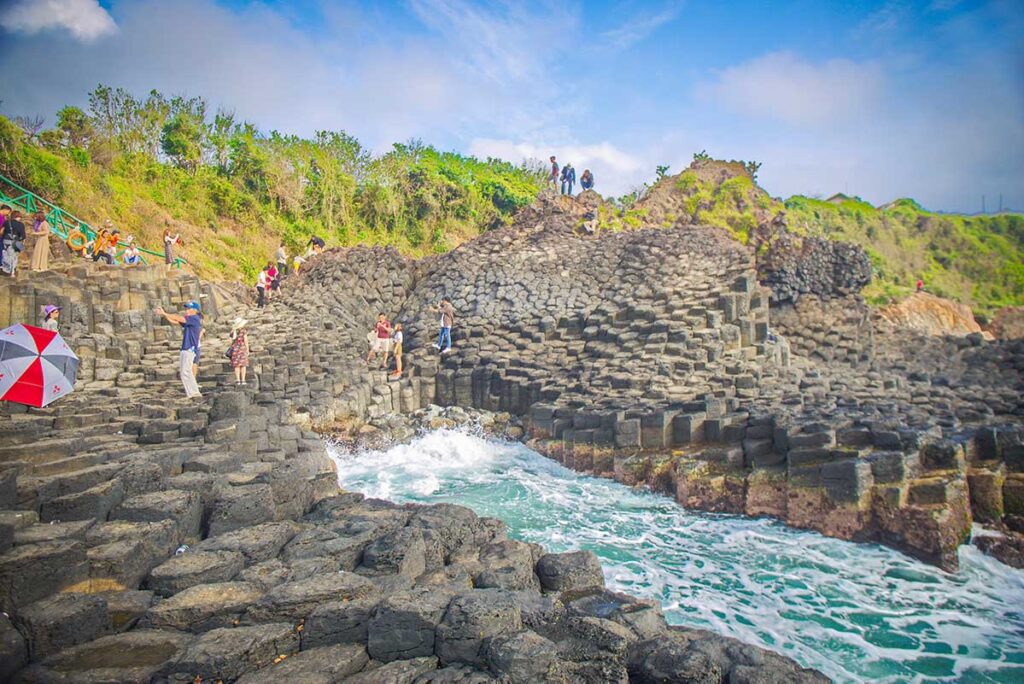

A little further along, there’s a quieter area where you can dip your feet or watch the waves crash into tide pools. The whole site is compact, and you’ll likely spend 30 to 60 minutes exploring unless you linger for photos or combine with nearby stops.
2. Entrance, Hours & Costs
Entry is usually around 40,000 VND per person, with parking charged separately. Bring small cash, as card payments aren’t accepted.
Official hours are often posted as 08:00 to 18:30, though in reality daylight matters more — locals visit early morning or near sunset. Some travelers mention inconsistent parking fees, so buy your entrance ticket at the official booth and keep change handy.
3. Facilities & Services reality
Facilities are basic but enough for a short visit. There’s a parking area, toilets, and a few shaded kiosks selling drinks, ice cream, or sugar-cane juice. Around the entrance you’ll find small souvenir stalls, some selling local snacks and seafood dishes. Quality varies, and toys or novelty items can be overpriced or disappointing, so check before you buy.
4. Safety & Etiquette on the rocks
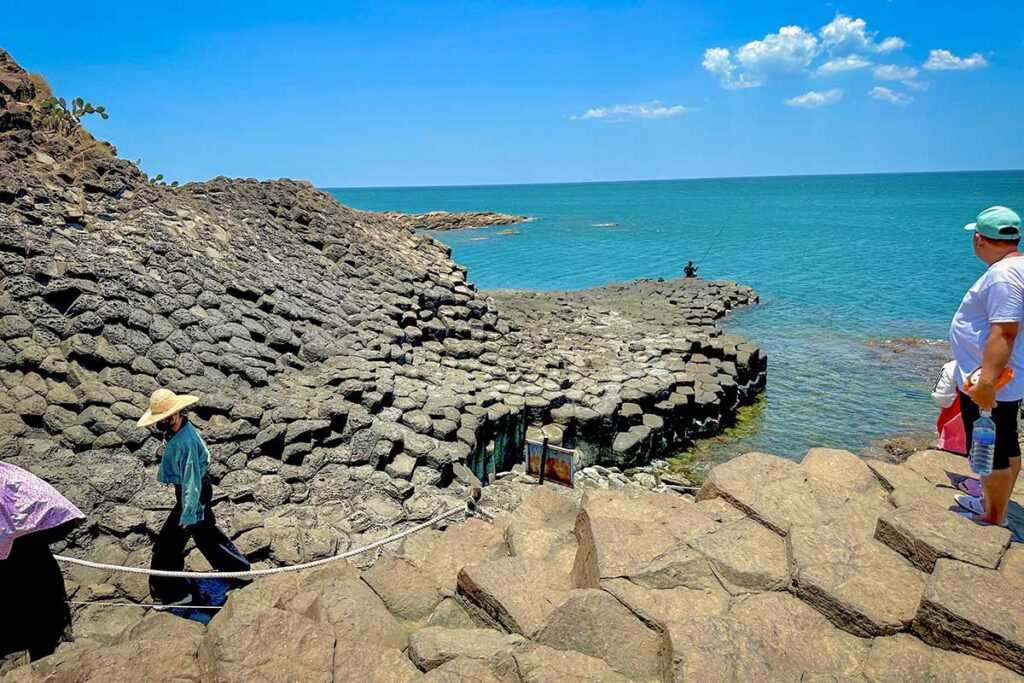
The rocks are uneven and can be slippery, especially near the waterline where waves hit. Wear shoes or sandals with a good grip rather than flip-flops, and avoid standing on the edges during rough seas. Follow ropes and signage where present, and resist climbing on fragile areas. Like many natural sites in Vietnam, leaving no litter is appreciated — the reef is relatively clean compared to other busy spots, and it’s worth helping to keep it that way.
5. Photo & Light notes

Da Dia Reef is particularly photogenic when the light is soft. At sunrise and sunset, the basalt columns shift in color, from jet black to reddish or golden tones depending on the angle of the sun. Midday can feel harsh, but shadows highlight the geometric patterns. If you fly a drone, be mindful of crowds and local sensitivities — wind along the coast can also make conditions tricky.
6. Easy Same-Trip Add-Ons
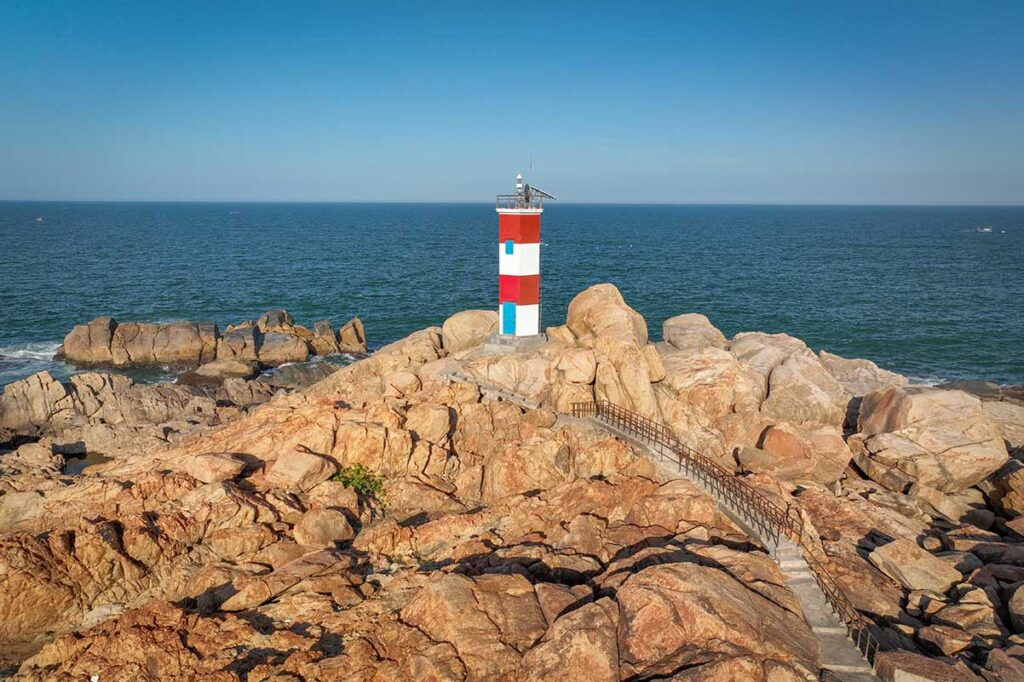
Many travelers pair Da Dia Reef with nearby sights. Ganh Den Lighthouse, just a kilometer or two away, offers great views of the coast and is easy to add to the same stop. A little further afield you’ll find coves and beaches like Bai Bang or Bai Xep, plus small fishing villages where boats and seafood drying racks give a glimpse of local life. These stops round out the reef visit into a half-day coastal loop rather than a stand-alone trip.
Best time to visit
By season
The best months to visit Da Dia Reef are during the dry season from January to August. During this period, skies are generally clearer, seas calmer, and the basalt formations easier to walk on. If you come in the rainy months, waves can pound the rocks, making them slippery and less enjoyable to explore. Stormy days also limit photo opportunities and comfort on site.
By time of day
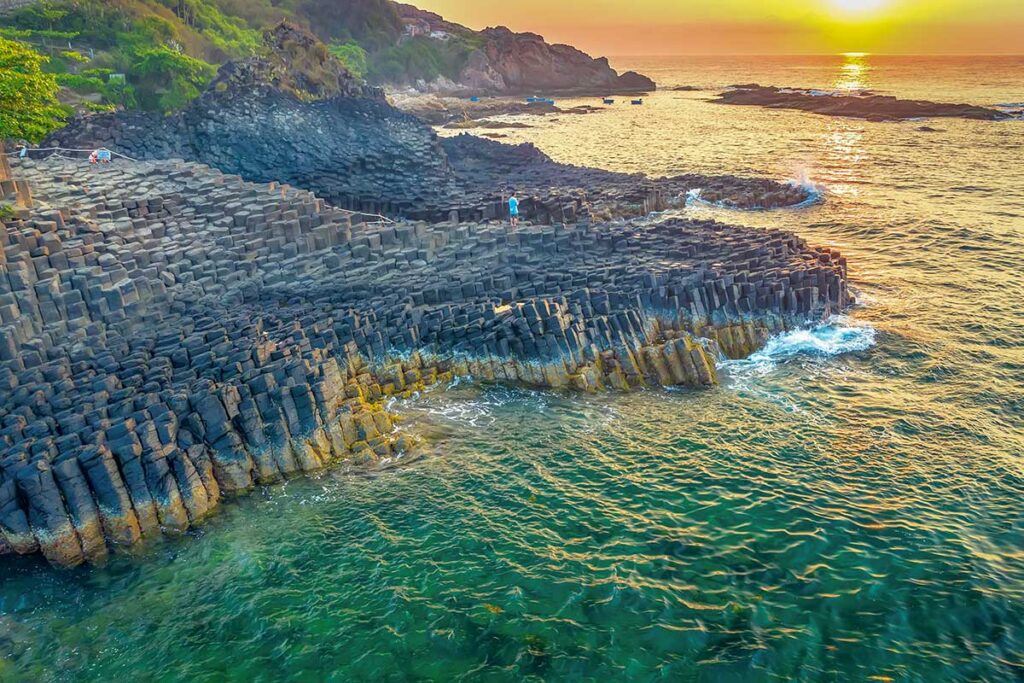
Light makes a big difference here. Sunrise and sunset are when the rocks look their most dramatic, shifting from deep black to reddish or golden tones. These times are also cooler and less crowded. Midday brings harsher sunlight, but the high angle of the sun can reveal the geometric cracks and sharp outlines of the columns.
Weather caveats
Keep in mind that Da Dia Reef is fully exposed to the coast. Strong winds or high swells can spray seawater across the rocks and make footing dangerous. On such days it’s best to avoid standing near the edge, and if conditions look unsafe, stick to the main viewing area rather than venturing close to the waterline.
Location & Getting there
Where is Da Dia Reef?
Da Dia Reef is in Tuy An District, about 30–38 kilometers north of Tuy Hoa City, the capital of Phu Yen Province. From Tuy Hoa it’s a 40–50 minute drive depending on which route you take. Tuy Hoa itself is easy to reach by domestic flight (daily services from Hanoi and Ho Chi Minh City) or by the Reunification railway, which stops at Tuy Hoa Station. This makes the city a practical base for exploring the reef and the wider coast.
Taxi or Ride-Hailing
You can take a regular taxi from Tuy Hoa to Da Dia Reef, but ride-hailing apps like Grab aren’t always reliable once you’re outside the city. If you go by taxi, it’s best to ask the driver to wait while you visit, or arrange a set pickup time, since getting a return ride on the spot can be difficult. Coverage and signal near the site can be patchy.
Car with Driver (Private Transfer)
Hiring a car with driver is the most convenient option if you’re planning a coastal day trip that includes Da Dia Reef along with nearby spots like Ganh Den Lighthouse, Bai Xep Beach, O Loan Lagoon, or Mang Lang Church. Prices are usually fixed in advance, and the driver will wait for you at each stop, which takes the stress out of finding transport back.
Renting a motorbike
For those comfortable riding, renting a motorbike in Tuy Hoa is the most flexible and budget-friendly way to reach Da Dia Reef. The ride north is straightforward via National Highway 1A or the more scenic coastal road. Expect occasional coastal winds and watch for sandy or gravel patches near villages. While rental shops rarely check paperwork, an International Driving Permit is officially required and may matter for your insurance. Riding gives you the freedom to stop at viewpoints and smaller beaches along the way.
Is Da Dia Reef worth visiting?
Da Dia Reef is one of those places that really makes you stop for a moment — the basalt columns are so precise and geometric that they almost look man-made. It’s instantly impressive when you first walk up, and if you catch it in the right light the rocks shift from deep black to golden hues. That said, it’s a compact site. You’ll probably spend less than an hour here, unless you take your time with photos or combine it with nearby spots.
You’ll appreciate it most if you enjoy photography, unusual geology, or coastal road trips. It’s also a fun break in a larger Phu Yen itinerary, especially if you like connecting short natural highlights into a scenic day. On the other hand, if you’re expecting a long sandy beach, swimming, or a half-day of activities, you may find it underwhelming.
The reef works best as a stop on a wider coastal loop: pair it with Ganh Den Lighthouse, O Loan Lagoon for seafood, and one of the nearby beaches or viewpoints. Taken together, the area makes for a memorable and varied day out, with Da Dia Reef as the geological highlight.
